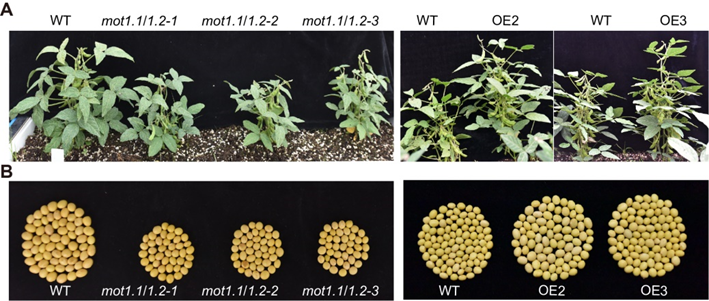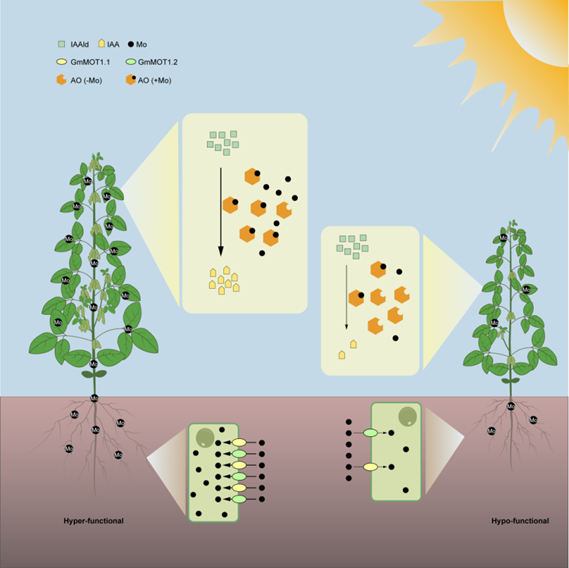In a study published in Current Biology on November 22, 2023, CHAO Dai-Yin’s group at CAS center for Excellence in Molecular Plant Science (CEMPS) of the Chinese Academy of Sciences and TIAN Zhixi’s group at Institute of Genetics and Developmental Biology (IGDB) of the Chinese Academy of Sciences reported identification of key genes controlling shoot molybdenum concentrations in soybean and unlocked the mystery of how molybdenum fertilizer boosts soybean yield..
Molybdenum is an indispensable trace element for plant growth. For leguminous plants, especially soybeans, molybdenum fertilizer is particularly important. The high demand for molybdenum fertilizer in leguminous plants is often assumed to be associated with their high molybdenum requirements for symbiotic nitrogen fixation. However, this hypothesis seems contradictory to the practical application of foliar molybdenum fertilization because nodule nitrogen fixation occurs at the root.
Soybean is the most important crop providing humans with essential protein and oil. Their yield is crucial for global food security and human health. However, whether the natural variation in molybdenum utilization exists among different soybean varieties, how these variations affect soybean production, and how to leverage these variations remain poorly understood.
Taking advantages of genome-wide association study and ionomics, the researchers identified two genes, GmMOT1.1 and GmMOT1.2, which control natural variation in molybdate uptake and transport in soybean. Further analysis revealed five major haplotypes of GmMOT1.1 and GmMOT1.2 in soybean varieties, with haplotype 5 exhibiting the highest expression and molybdenum transport capacity, while haplotype 4 showed the lowest expression and transport capacity. A series of genetic and molecular experiments indicated that GmMOT1.1 and GmMOT1.2 are involved in molybdate uptake in the roots and root-to-shoot transport of molybdate. When the functions of GmMOT1.1 and GmMOT1.2 were impaired, both molybdenum content and yield of soybean were significantly decreased, while enhancement of their function substantially improves molybdenum utilization and soybean yield.
Figure 1. GmMOT1.1 and GmMOT1.2 contribute to soybean yield
Interestingly, GmMOT1.1 and GmMOT1.2 do not affect the nitrogen-fixing ability of root nodules or other nitrogen assimilation processes in soybeans. On the contrary, the study discovered a molybdenum-binding aldehyde oxidase in soybean leaves that catalyzes auxin synthesis, and its catalytic activity depends on molybdenum content. When the functions of GmMOT1.1 and GmMOT1.2 are enhanced, leaf molybdenum concentration increases, promoting auxin synthesis and leaf growth, ultimately increasing soybean yield. This result perfectly explains why spraying molybdenum fertilizer directly on leaves can boost soybean production in agriculture.
Figure 2. A diagram of the working model of GmMOT1.1 and GmMOT1.2
Furthermore, the research found that distribution of different haplotypes of these two genes is closely related to soil pH. Hyper-functional haplotypes are mainly distributed in acidic, low-molybdenum soil areas, while hypo-functional haplotypes tend to be found in alkaline, high-molybdenum soil areas. This result suggests that these two genes can be used to design molecular markers for breeding customized soybean varieties adapted to different soil pH levels.
The study reveals the genetic basis underlying natural variation in molybdenum content in soybean, uncovers the mechanism underlying foliar molybdenum fertilizer promoting soybean yield in legume crops, and identifies molecular markers for custom soybean breeding based on soil pH. This provides a strong scientific basis for further optimizing soybean cultivation and breeding strategies to cultivate nutrient-efficient soybean varieties.
Professor CHAO Dai-Yin and Professor TIAN Zhixi are the corresponding authors of this paper. Zhang Jing, a PhD student at CEMPS, and Associate Professor Liu Shulin from IGDB are co-first authors. This work was supported by the Key Research Program of Chinese Academy of Sciences (ZDRW-ZS-2019-2) and the Strategic Priority Research Program of Chinese Academy of Sciences (XDB27010103).
Contact:
Dr. Daiyin Chao, Professor
National Key Laboratory of Plant Molecular Genetics, Center for Excellence in Molecular Plant Sciences, Chinese Academic of Sciences
Email: dychao@cemps.ac.cn

